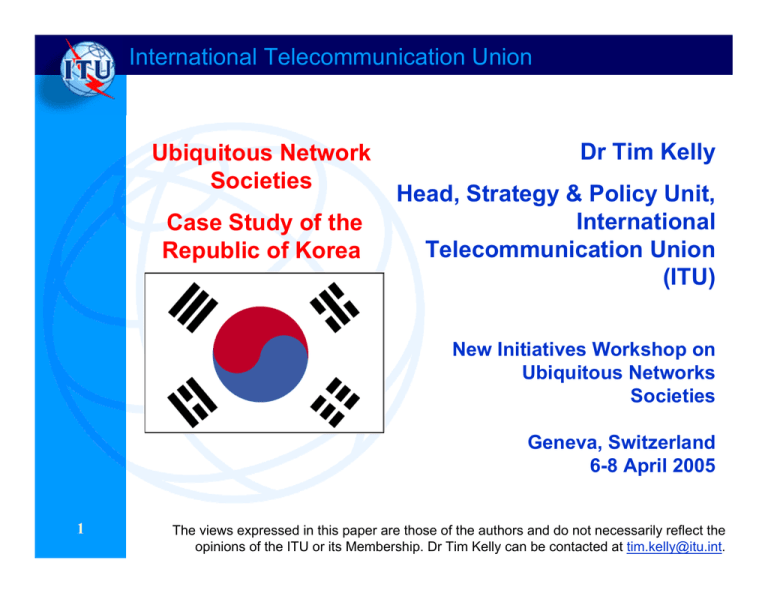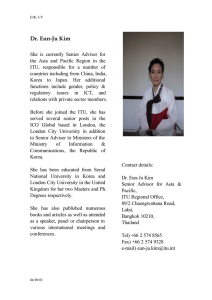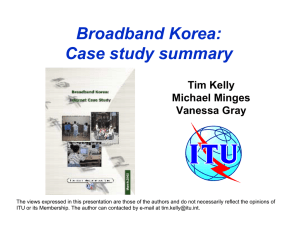International Telecommunication Union Dr Tim Kelly Head, Strategy & Policy Unit, International
advertisement

International Telecommunication Union Ubiquitous Network Societies Case Study of the Republic of Korea Dr Tim Kelly Head, Strategy & Policy Unit, International Telecommunication Union (ITU) New Initiatives Workshop on Ubiquitous Networks Societies Geneva, Switzerland 6-8 April 2005 1 The views expressed in this paper are those of the authors and do not necessarily reflect the opinions of the ITU or its Membership. Dr Tim Kelly can be contacted at tim.kelly@itu.int. Broadband per 100, Korea (Rep.) HK, China Top 20, 1 Jan 2005 Netherlands z Korea is (still) #1 worldwide in broadband penetration z Around 80% of homes subscribe to broadband z Korea has benefited from platform competition: ¾ ¾ ¾ ¾ 24.9 20.9 19.4 19.3 17.6 17.0 16.3 16.0 15.5 15.1 15.0 14.3 14.1 Overall 12.8 broadband 11.6 penetration rate 11.4 DSL 11.2 10.3 Cable 10.1 Modems and Other 8.5 Denmark Canada Switzerland Taiwan, China DSL technologies Cable Modem Appartment LANs Wireless LANs, satellite etc z Very low price per (e.g., <US$25 per month for 2Mbit/s) Note: Figures used in slide do NOT include wireless broadband (e.g., 3G). Source: ITU World Telecom Indicators Database. Belgium Iceland Sweden Norway Israel Japan Finland Singapore USA France UK Austria Portugal - 5 10 15 20 25 30 Korea is also a world leader in 3G mobile HK, China, 0.7% UK, 3.7% CDMA 1xEV-DO subscribers Other WCDMA, 2.0% Italy, 6.7% Japan, 31.8% W-CDMA subscribers z By June 2004, there were around 35m mobile handsets, of which: Korea 1xEV-DO, 53.7% Other Korea, W-CDMA EVDO, 0.3% 1.0% ¾ 22m CDMA 1x ¾ 8m CDMA 1x EVDO CDMA 1x subscribers Korea, 21.8% Estimated total at 30 June 2004 = 14.9 million z In addition to CDMA 2000, W-CDMA and WiBro have been licensed z Also >360’000 WLAN subscribers at end 2003 Rest of the world, 63.9% Japan, 14.3% Estimated total at 30 June 2004 = 103 million Korea’s unique public/private cooperation Prepare for ubiquitous network society: improve competitiveness Maximise ability of all citizens to use ICTs Vision of a creative knowledgebased society IT 839 Strategy (2004-07) E-Korea Vision 2006 (2002-2006) CYBER KOREA 21 (1999-2002) Ten priority areas Annual action plans National Framework Plan for Informatization Promotion (1996-2000) National information superhighway Korea Information Infrastructure Initiative (1995-2005) Administration, defence, public security, finance & education Focus on manufacturing National Basic Information System (1987 – 1996) Measures to nurture IT Industry (1987 – 1985) International Telecommunication Union Korea’s IT 839 Strategy 8 services WiBro Service DMB Service Home Networking Telematics Service RFID based W-CDMA Service Terrest. Digital TV VoIP 5 Source: MIC Korea. 3 infrastructures Broadband Convergence Network (BcN) Ubiquitous Sensor Network (USN) Next-Generation Internet Protocol (IPv6) 9 new growth engines Next-Generation Mobile Communications Digital TV Home Networking IT System on Chip Next-Generation PC Embedded Software Digital Contents Telematics Intelligent Service Robot Licensing WiBro z Licensees: ¾ KT ¾ Hanaro ¾ SKT Frequency: Licenses: 2.3 GHz 3 awarded (Feb 2005) Bandwidth Per user: 1-2 Mbit/s Total: 100 MHz Maximum accessible speed for users: Practical: 60 km/hour Theoretical: 250 km/hour Pricing estimates Monthly unlimited use: Flat rate, est. 15 USD Source: MIC Korea. International Telecommunication Union Selected examples of ubiquitous networks in Korea z Digital TV delivered to mobiles ¾ DMB service z Mobile handsets used as wallets ¾ “Moneta” service z Telematics (automobile/mobile) ¾ “Nate Drive” z Avatars in gaming ¾ Fashion wardrobes for avatars z Self-adaptive telephones that find the cheapest networks 7 ¾ “Nespot SWING”, “One-Phone DU” International Telecommunication Union Conclusions z Korea as a laboratory of the future ¾ ~ Three years ahead of Europe in broadband ¾ ~ Two years ahead of Europe in 3G mobile z Korea as an example of public/private policy partnership Source: ITU World Telecom Indicators Database. ¾ Strategy of picking technological winners ¾ Gov’t reinvestment of profits from spectrum auctions z Korea creating new revenue 8 ¾ Twice the global rate of growth in telecom spend as % of GDP 5.0% 4.5% Korea (Rep.) 4.0% 3.5% 3.0% 2.5% World 2.0% 1.5% 1.0% 1992 2002 Telecoms revenue as a % of GDP International Telecommunication Union Thank you The full case study (50pp) is available at http://www.itu.int/ubiquitous Tim Kelly Tim.kelly@itu.int 9







